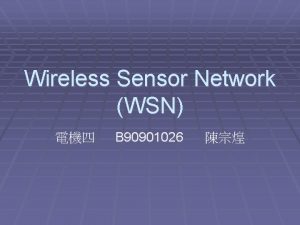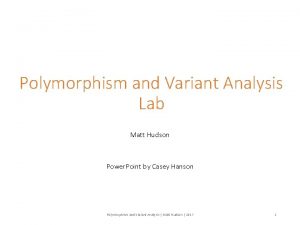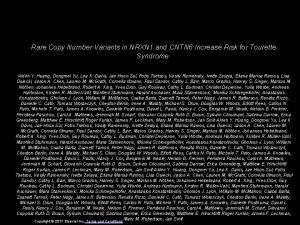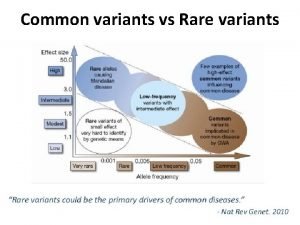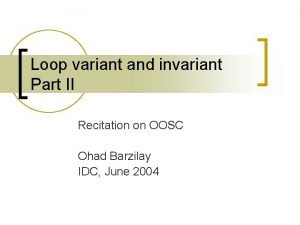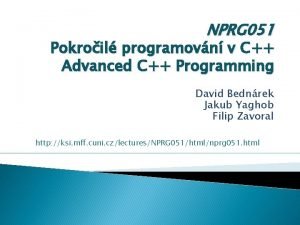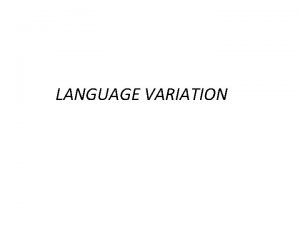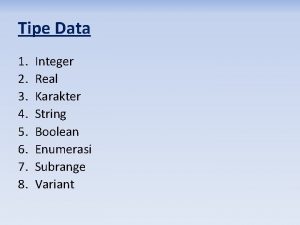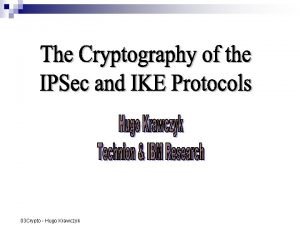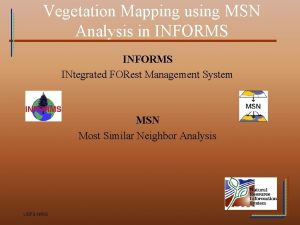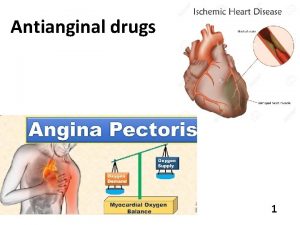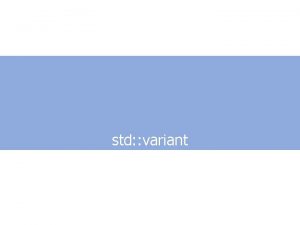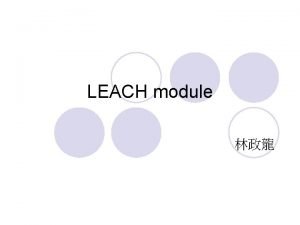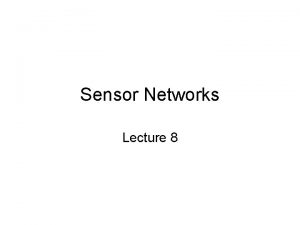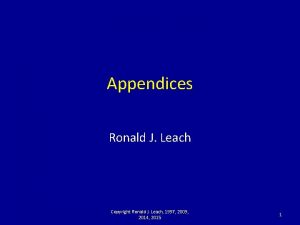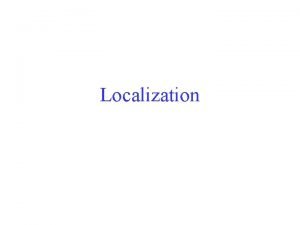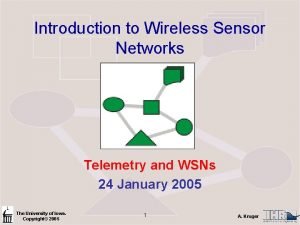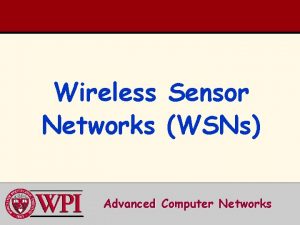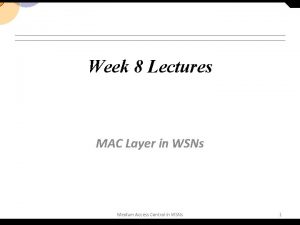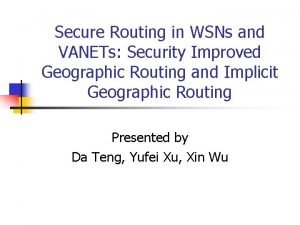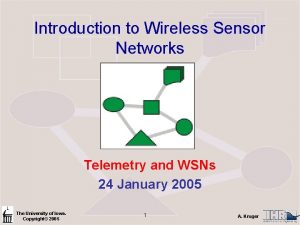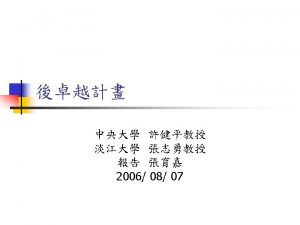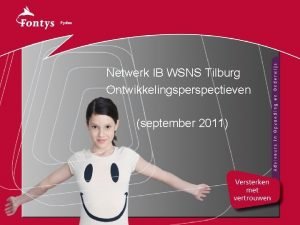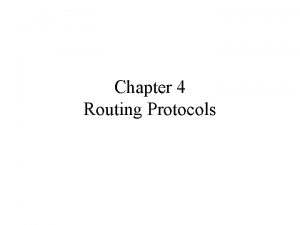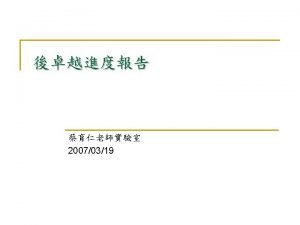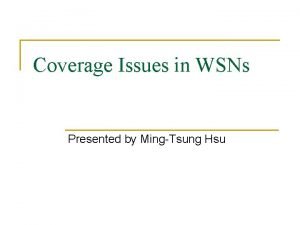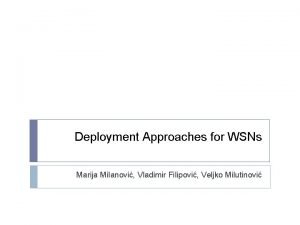MODLEACH A Variant of LEACH for WSNs Prepared



























- Slides: 27

MODLEACH: A Variant of LEACH for WSNs Prepared by: Danish Mahmood

Abstract • Cluster Based Routing in Wireless Sensor Networks • We divided our work into two parts • First phase: – Modification in LEACH protocol • Efficient Cluster Head Replacement scheme • Dual Transmission power levels • Second Phase – Implement soft and hard thresholds in MODLEACH – Performance analysis with respect to network stability, throughput and cluster head formation. MODLEACH: A Variant of LEACH for WSNs. 2

Introduction: Routing in Wireless Sensor Networks • Major Limitations of Wireless Sensor Networks. – Energy – Uncontrolled environment • Role of routing protocol to cope with these limitations – Minimal usage of energy is key responsibility of routing protocol running on WSN however, environment can not be controlled fully. MODLEACH: A Variant of LEACH for WSNs. 3

Cluster Based Routing (1) • In clustering, whole network is divided into fixed or variable sized clusters containing sensor nodes in it. • Each cluster is represented by a cluster head that is responsible for communication between base station/ sink and other non cluster head nodes. • Non cluster head nodes of cluster communicates only with cluster head hence minimizing energy utilization. MODLEACH: A Variant of LEACH for WSNs. 4

Cluster Based Routing (2) BS MODLEACH: A Variant of LEACH for WSNs. 5

Cluster Based Routing (3) • Here nodes are organized into clusters that communicate with a local BS (CH) and these local Base Stations transmit the data to the global BS, where it is accessed by the end user. • Reduced distance of data transmission as the local BS (CH) is typically close to all nodes in the Cluster but BS becomes energy constrained • As soon as cluster -head node dies, all nodes from that cluster effectively die since there is no way to get their data to the base station. • In Adaptive clustering, cluster heads change as nodes move in order to keep the network fully connected MODLEACH: A Variant of LEACH for WSNs. 6

Cluster Based Routing (4) • Cluster based routing has proven itself as efficient routing strategy in WSNs. • Many routing protocols are derived using clustering mechanism that gives efficient wireless sensor network. • LEACH, being the parent routing protocol receives many enhancements. MODLEACH: A Variant of LEACH for WSNs. 7

MODLEACH • To understand the proposed modifications or enhancements in LEACH, • we initially have to understand – Functionality & – operability of LEACH protocol. MODLEACH: A Variant of LEACH for WSNs. 8

LEACH Routing Protocol • LEACH (Low-Energy Adaptive Clustering Hierarchy) is a routing protocol for wireless sensor networks in which: – The base station (sink) is fixed – Sensor nodes are homogenous • LEACH conserves energy through: – Aggregation – Adaptive Clustering MODLEACH: A Variant of LEACH for WSNs. 9

LEACH Properties • Adaptive Clustering – Distributed • Randomized Rotation – Biased to balance energy loss • Heads perform compression – aggregation • In-cluster TDMA MODLEACH: A Variant of LEACH for WSNs. 10

LEACH Functioning (1) • Cluster Head and Cluster Formation: – Leach is based on adaptive Clustering. – Every node has equal chances to be a cluster head – Sensors elect themselves to be the local cluster heads at any given time with a certain probability, and broadcast their status to other sensors each sensor node choosing the cluster-head with strongest signal (can minimize transmission power) MODLEACH: A Variant of LEACH for WSNs. 11

LEACH Functioning (2) • Randomized Rotation – The high energy cluster head position rotates among the various sensors in order to not to drain the battery of a single sensor. (currently just random) – Sensors elect themselves to be the local cluster heads at any given time with a certain probability, and broadcast their status to other sensors each sensor node choosing the cluster-head with strongest signal (can minimize transmission power) MODLEACH: A Variant of LEACH for WSNs. 12

LEACH Operation • The operation is broken up into rounds – Advertisement phase • use CSMA MAC protocol, and all cluster heads transmit with same energy – Set up phase : Cluster is organized • each node transmits to which cluster head it wants to belong to using a CSMA MAC – Steady State Phase: Data Transfers to Base Station occur MODLEACH: A Variant of LEACH for WSNs. 13

Problems and their solutions • LEACH gives adaptive clustering mechanism which very efficiently deals with energy conservations. • However, Leach doesn’t take account of residual energy of a node. – To address this, a novel technique as efficient Cluster head Replacement is proposed. • LEACH use same amplification energy for both kinds of transmissions i. e. CH to BS and CM to CH. – To address this, multi amplified power levels are introduced. MODLEACH: A Variant of LEACH for WSNs. 14

Modifications in LEACH: MODLEACH (1) • For every round, protocol will check if energy of Cluster Head has fallen a defined threshold than it will undertake CH and cluster formation process. Else same CH will continue its operations. • This is how much of energy that goes wasted in cluster head formation process can be saved. Moreover, control overhead is also limitized. MODLEACH: A Variant of LEACH for WSNs. 15

Modifications in LEACH: MODLEACH (2) • In an adaptive clustering hierarchic, there can be three kinds of communications w. r. t distances. – Inter cluster communication. – Intra cluster communication. – Cluster head to base station/ sink communication. • Using equal signal amplification energy for all of above communications is also not needed. Hence multi power levels are adjusted for all three kinds of communication to preserve energy. MODLEACH: A Variant of LEACH for WSNs. 16

MODLEACH • Basically, in MODLEACH, two modifications/ enhancements are made. • These enhancements are (as discussed earlier): – Efficient cluster head replacement technique – Dual amplification power levels MODLEACH: A Variant of LEACH for WSNs. 17

LEACH Vs MODLEACH: A Variant of LEACH for WSNs. 18

MODLEACH with Hard and Soft Threshold. • Implementation of hard and soft threshold in MODLEACH gives much better results • Reactive nature of routing protocol not only result in lower routing over head but also better network life time. • Applying thresholds in MODLEACH make the protocol reactive in nature. MODLEACH: A Variant of LEACH for WSNs. 19

Simulations Tool and Parameters • Simulations are conducted using MATLAB (R 2009 a) and to get precise plots, confidence interval is taken. MODLEACH: A Variant of LEACH for WSNs. 20

Simulation Results • Simulations show that MODLEACH performs better considering metrics of throughput, network life time, and optimized cluster head formation of network w. r. t LEACH. • MODLEACH is further improved by using the concept of soft and hard threshold as introduced by TEEN. MODLEACHHT further improve efficiency however, MODLEACHST performs best amongst all. MODLEACH: A Variant of LEACH for WSNs. 21

Metrics under consideration • LEACH, MODLEACHHT and MODLEACHST are simulated keeping – Network life time – Throughput – Cluster head formation and scope Under consideration MODLEACH: A Variant of LEACH for WSNs. 22

Network Life Time • MODLEACHST gives maximum network life time amongst all protocols. • Reasons are: – Concept of soft threshold – Efficient cluster head replacement technique – Dual amplification power levels for inter and CH to Bs communications. MODLEACH: A Variant of LEACH for WSNs. 23

Throughput • • Maximum throughput is achieved by MODLEACHST. Comparing MODLEACH and LEACH, MODLEACH gives better throughput – increased network life time due to dual amplification power levels and better cluster head replacement scheme. • the mode of operation. – LEACH and MODLEACH both are proactive (periodical transmissions) in nature while MODLEACHHT and MODLEACHST are reactive (event driven). • This also depicts that – proactive routing protocols have lower throughput than reactive routing protocols. MODLEACH: A Variant of LEACH for WSNs. 24

Cluster head formation and scope • Figure 6 (next slide) and Figure 7 show number of cluster heads chosen at each round. • All the techniques basically used same algorithm hence no major difference is there in cluster head formation and calculation manner • However, MODLEACH differs from LEACH in a sense that initially its number of cluster heads remain stable and then cluster head formation behavior goes similar to that of LEACH. MODLEACH: A Variant of LEACH for WSNs. 25

Cluster head formation and scope • Initially as modified in LEACH, MODLEACH executes same cluster heads for next round/s if they have energy greater than defined threshold. • This is the reason of stable number of cluster heads initially. MODLEACH: A Variant of LEACH for WSNs. 26

Conclusion • In this work, we propose MODLEACH, a new variant of LEACH • The two techniques utilized in MODLEACH can further be utilized in other clustering routing protocols for better efficiency. • MODLEACH tends to minimize network energy consumption by – efficient cluster head replacement after very first round and – dual transmitting power levels for intra cluster and cluster head to base station communication. • Further, soft and hard thresholds are implemented on MODLEACH to give a comparison on performances of these protocols considering throughput and energy utilization. • In future, we will carry our work – to calculate routing load of MODLEACH, MODLEACHST and MODLEACHHT analytically – And to apply efficient cluster head replacement mechanism along with dual transmission power levels in other clustering routing protocols of wireless sensor networks to study their impact in a broader sense. MODLEACH: A Variant of LEACH for WSNs. 27
 Synthesis phase of assembler
Synthesis phase of assembler Wsns
Wsns What did richard maddox invent
What did richard maddox invent Darren leach
Darren leach Kimberly leach cuerpo
Kimberly leach cuerpo Community leach pit
Community leach pit Isabella leach
Isabella leach Tonic dialogue
Tonic dialogue Professor graham leach
Professor graham leach Snp variant
Snp variant Variant analysis
Variant analysis Nrxn copy number variant
Nrxn copy number variant Tiopurine
Tiopurine Intel 8086 block diagram
Intel 8086 block diagram What is loop variant
What is loop variant Nprg051
Nprg051 Snp variant
Snp variant Regional variation in sociolinguistics
Regional variation in sociolinguistics #**# merupakan karakter yang terdapat pada type data
#**# merupakan karakter yang terdapat pada type data Sigma variant
Sigma variant Fvs variant map
Fvs variant map Atherosclerosis plaque development
Atherosclerosis plaque development Variant math
Variant math Reported speech s2
Reported speech s2 Plug flow dryer is variant of
Plug flow dryer is variant of The correct variant of present simple
The correct variant of present simple Snp variant
Snp variant Variant angina
Variant angina

